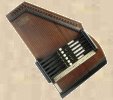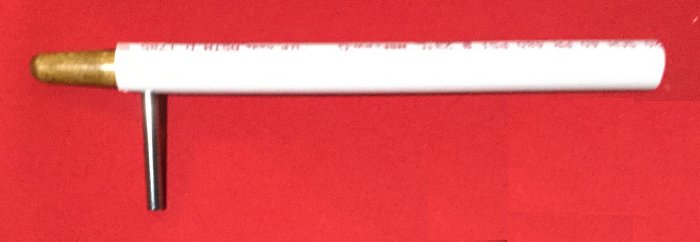|
|
  
Autoharp Gadget #2
The Autoharp Fine Tuner Bar

About 40 years ago, when I found gigs as a banjo player to be somewhat few and far between, I started playing piano in some of the better bars in the Houston area.
A friend of mine who was also a piano player told me that most piano bar pianos were really terrible, and I would need to know how to tune a piano as well as perform minor maintenance on it.
That's where I learned about piano tuning hammers.
A tuning hammer isn't actually a hammer. It's a wrench, but it is very special. It has a star head, rather than a square head (on the better models) and the handle is about a foot long. The biggest advantage of this over the relatively short-handled tuning wrench we use on autoharps is that you have to move the end of the handle a longer distance in order to obtain the same pitch differences that you would get with a shorter handled wrench or tuning hammer. If you have a tuning wrench with a handle 4 inches long, and you move the end of that handle an inch, you will get a pitch change of about a quarter tone, depending, of course, on the string. If you have a handle that is 12 inches long, when you move the end of the handle an inch, you get a pitch change that is considerably less. So you don't really need "fine tuners" on a piano.
The Fine Tuner Bar was inspired by my piano tuning hammer, as well as "cheater pipes" that people used to keep in the trunks of their cars to help a tire wrench undo a stubborn lug nut.
I came up with this idea in March of 2018, but I'm sure that others have had similar ideas.
Here's how it works.
First, you need an autoharp tuning wrench. This is the one I use.

Many of you may already have one of these. If not, the wrench that looks like an "L" will also work. You just may need a larger or smaller diameter of plastic pipe.
Go to your favorite big box store, such as Lowe's, The Home Depot, B&Q, and take your tuning wrench with you. In the plumbing department, there will usually be a rack with sections of PVC plumbing pipe about 2 feet long. Get one of these that will fit snugly over the handle of your wrench. In the case of the T-wrench I used, that's a piece of ¾ inch plumbing pipe. You want Schedule 40 pipe so it doesn't bend too much as you are tuning.
Go over to the tool department and get a drill bit that is the same diameter as the business end of your wrench -- the part that fits over the tuning pegs. This will vary, according to which wrench you have. In addition to these, you will also need a pair of diagonal wire cutters. You probably already have a set of these around the house.
Once you have all of this, go out to your garage or workshop, and cut off a piece of this pipe about a foot long. It should look like this:

Mark a spot about 3/4 inch (18mm) from the end of the pipe.

Now, drill a hole the size of the part of wrench that you put over the tuning peg right where that spot is.

The project is almost completed. Once you have drilled the hole, use your diagonal wire cutters to form the notch or slot that goes from the end of the pipe to the hole. Just cut away the plastic pipe on either side of the area leading to the hole.

When you slide the wrench into the end of the PVC pipe handle, if you use just a little force, the pipe will lock around the wrench, and it will look like this:

The closed end of the notch is rounded to accommodate the wrench part of this style of autoharp tuning wrench.
Don't worry too much if the wrench doesn't snap into place the first time you push it home. You may need to remove just a small amount of the pipe at the leading edge of the hole.
To use the Autoharp Fine Tuning Bar, simply slide your wrench into the pipe, place the wrench over the tuning peg that needs to be adjusted, and gently move the end of the bar in the direction it needs to go. You will be amazed at how well this works.
Return to home page.
*Dobro is a registered trademark of Gibson, USA.
copyright 2020, by Bill Palmer. All rights reserved.
To contact Bill send an email to
bill@billpalmer.com.
| |